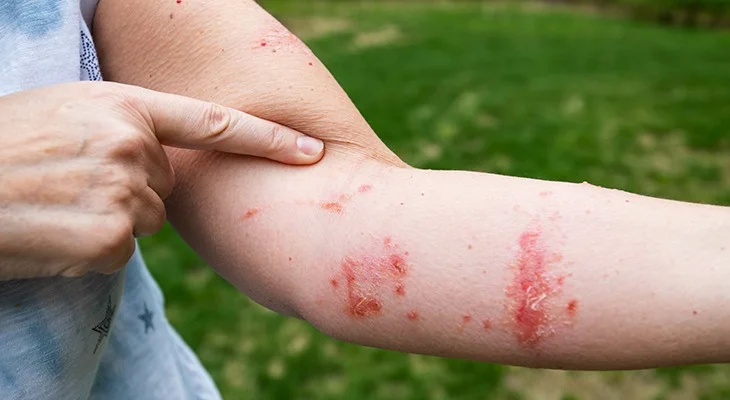Written by Dr. Ringpfeil

Poison ivy is a plant that induces contact dermatitis, causing a red, itchy rash accompanied by small bumps, blisters, or swelling. The rash results from urushiol, an oily plant resin found in poison ivy, poison oak, and poison sumac. Even a minuscule amount of urushiol can instigate a reaction. It adheres to the skin, clothing, tools, equipment, and pet fur, leading to the spread of the rash. Treatment primarily focuses on alleviating itching until the reaction naturally subsides.
Symptoms of a poison ivy rash encompass redness, itching, swelling, and blisters. The rash usually manifests within a few days after coming into contact with the plant’s oils and lasts for up to three weeks. The rash’s intensity can vary, presenting as a highly pruritic red rash with streaks or patches where the plant made contact with the skin. It can extend from the initial contact site. Red bumps and potentially sizable, oozing blisters may also be evident.
Poison ivy rashes resolve on their own and are not contagious. Nonetheless, certain situations warrant medical attention, such as severe or widespread reactions, rashes affecting sensitive areas like the eyes, mouth, or genitals, large blisters, or the presence of a fever. Scratching the rash with unclean fingernails can result in secondary bacterial infections and pustular blisters. Addressing a secondary infection typically involves prescription antibiotics. In rare instances, severe poison ivy reactions may necessitate hospitalization.
Due to urushiol’s swift penetration of the skin, prompt washing of the affected area with soap and water or an oil-removing product like Tecnu within 30 minutes of exposure is vital. Thoroughly cleaning under the fingernails helps prevent the resin’s spread. In most cases, the rash resolves naturally within one to three weeks. Over-the-counter remedies such as calamine lotion, hydrocortisone cream, or aluminum acetate (Domeboro solution) soaks can offer relief from symptoms. Antihistamines can mitigate severe itching. In severe cases, especially when the rash is present on the face or genitals, a doctor may prescribe oral or injected steroids.
Thankfully, the poison ivy rash and blister fluid aren’t communicable. To prevent further contact, meticulously clean any potentially contaminated items. If urushiol has left black stains on clothing or utensils, it’s advisable to discard them as thorough cleansing is no longer feasible. Gently washing the skin within minutes of exposure can help minimize the risk of a reaction.
The optimal way to avert an allergic or irritant reaction to urushiol involves evading contact with poison ivy, poison sumac, and poison oak. Acquaint yourself with their appearance and common locations. Typically, these plants have leaves with three or more leaflets and tend to climb on other plants or fences. When hiking or participating in activities that could expose you to poison ivy, strive to stay on cleared pathways. If present, remove poison ivy from your backyard.
Patients ask Dr. Ringpfeil answers
Please feel free to use this form to ask our dermatologists questions about this treatment.